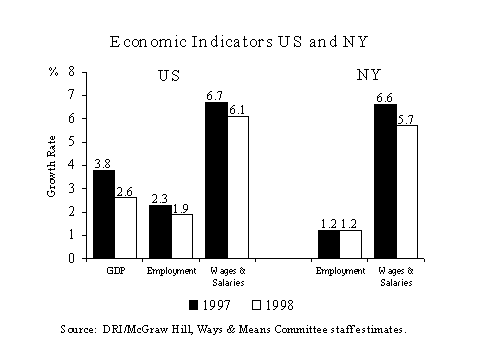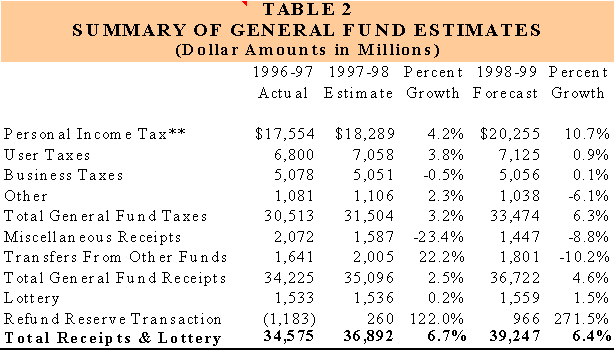Figure 2

New York is lagging in virtually every sector of the economy. In terms of rates of job growth, the State ranked consistently in the bottom 20 in every sector with the exception of the transportation, communication, and utilities sector. New York lags behind even when compared to its eight neighboring states in the Middle Atlantic and New England regions. The Committee staff predicts State job growth of 1.2 percent for 1998, compared to 1.9 percent growth for the nation (see Figure 1). Consistent with recent trends, New York employment growth will be led by the service sector, while the manufacturing sector will continue to experience job declines.
At this writing, it is uncertain how the Asian crisis will affect the U.S. economy and the current bull market. Nevertheless, we can still expect a successful year on Wall Street related to continuing high levels of merger and acquisition activity, as well as a large volume of corporate debt underwriting which tends to be associated with low interest rates. The total volume of corporate underwriting in the United States reached $1.3 trillion, exceeding the volume of any previous year. Moreover, the volume of mergers and acquisition transactions announced in 1997 reached $917.7 billion, exceeding the 1996 total by 46.5 percent and more than doubling the value of deals completed in 1995. Continuing success should translate into continuing high levels of bonus income for the 1998-99 bonus season.
Figure 2
It is no surprise that the FIRE sector experienced the fastest rate of wage growth. The average annual FIRE sector wage increased 25.5 percent over the period from 1992 to 1996, a reflection of strong financial market performance. Moreover, this increase in the average wage is accounted for by a dramatic increase in the number of workers earning $100,000 and above from just over 100,000 employees in 1992 to about 156,000 by 1996. In contrast, the number of employees earning less than $30,000 fell during the period due to downsizing in the commercial banking and insurance industries. The State’s health care industry has also undergone a substantial degree of downsizing, particularly among employees’ earning less than $30,000 per year, with very little growth in the income ranges above $50,000. The average health industry wage grew by only 8.1 percent during the period.
The State’s business and professional services firms serve not only the local market in which they reside, but a national market as well. Therefore, the business and professional services industry has benefited not only from growth on Wall Street, but also from the strength of the national expansion. The average wage for the industry group grew a healthy 13.7 percent over the period. The absence of a significant shift in the industry wage distribution indicates that the rise in the average wage has been the result of wage increases across the board, rather than a consequence of either downsizing on the lower end of the wage-scale or a concentration of wealth at the upper end.
The Committee staff predicts New York personal income to grow 5.8 percent and 5.3 percent for 1997 and 1998, respectively. The largest component of personal income—wages and salaries—will grow 5.7 percent in 1998, following 6.6 percent growth in 1997 (see Figure 1).
The strength of the national economy has provided modest improvement in New York State job growth. Gains in the service sector have been offset by continued job losses in the manufacturing sector. However, it is the strong performance of Wall Street, which has allowed General Fund taxes to overcome $2.0 billion in tax reductions in State Fiscal Year 1997-98, and show modest growth of 3.2%. In addition, receipts for the current fiscal year were buoyed by the cut in the Federal Capital Gains Tax. Favorable taxation of capital gains income at the Federal level will increase the realization of capital gains income for New York.

Figure 3
While the Personal Income Tax comprises the lion’s share of General Fund receipts, other taxes also contribute substantially. Business Taxes, for example, account for 14 percent of the total. However, these taxes tend to be quite volatile, especially over the past few years. This volatility can result from changes in the economy as well as from fluctuations in audit collections within these taxes. User Taxes tend to be more stable from year-to-year. They do, however, appear to change in tandem with the economy as it expands and contracts. All in all, General Fund tax receipts are affected by the changes in the domestic economy, the globalization of markets and Wall Street activity.
For State Fiscal Year 1997-98, the Executive Budget predicts a surplus of $1.83 billion. The Enacted Financial Plan included a $530 million surplus for State Fiscal Year 1997-98. This was unchanged in the Mid-Year Update to the Financial Plan. The current surplus is estimated to be $1.3 billion higher than that projected mid-way through the fiscal year. The primary reason for this disparity is increased revenue projections.
The Committee Staff forecast for this fiscal year and next is $944 million higher than the Executive, and is mainly the result a slightly more optimistic outlook for both the national and State economies. The Committee Staff also projects a stable economy, coupled with low inflation, which will continue to support strong wage and capital gains growth as well as the current bull market. The strength of Wall Street, and continued expansion of the economy, is evident in the State’s tax structure through growth in the Personal Income and Corporate Franchise Taxes. The stable economy will continue to generate high levels of consumer confidence and create modest improvement in the Sales and Compensating Use Tax.
The Committee Staff projects that General Fund and Lottery receipts will total $ 36,892 million in State Fiscal Year 1997-98, an increase of $2,317 million, or 6.7%, over State Fiscal Year 1996-97. The Committee Staff estimate is $125 million higher than the Executive’s estimate for State Fiscal Year 1997-98. General Fund tax revenues, however, are only estimated to increase by 3.2 percent over State Fiscal Year 1996-97. The growth in tax revenues, however, has been affected by tax reductions enacted by the State over the past few years. State Fiscal Year 1997-98 receipts are reduced by over $2.0 billion in tax reduction that took effect this year. Absent these tax reductions, growth in tax revenue for State Fiscal Year 1997-98 would have increased by 8.2 percent.
The Committee Staff projects that General Fund and Lottery receipts will total $39,247 million in State Fiscal Year 1998-99, which represents an increase of $2,355 million, or 6.4 percent, over State Fiscal Year 1997-98. The Committee Staff estimate is $819 million higher than the Executive’s estimate for State Fiscal Year 1998-99. This difference is largely attributable to differences in economic projections and how this translates into receipts. General Fund tax revenues are expected to increase by 6.3 percent in State Fiscal Year 1998-99. Again, absent the tax reductions, growth in tax revenue would total 7.2 percent.
For comparability purposes, the State Fiscal Year 1998-99 Committee Staff forecast also incorporates the Executive’s proposed tax cut program of $175 million. However, the forecast does not incorporate the Executive’s proposal to transfer $724 million in General Fund receipts to a new proposed Special Revenue Fund. These funds would be used to reimburse local governments for property tax revenues forgone as a result of the School Tax Relief Program (STAR).